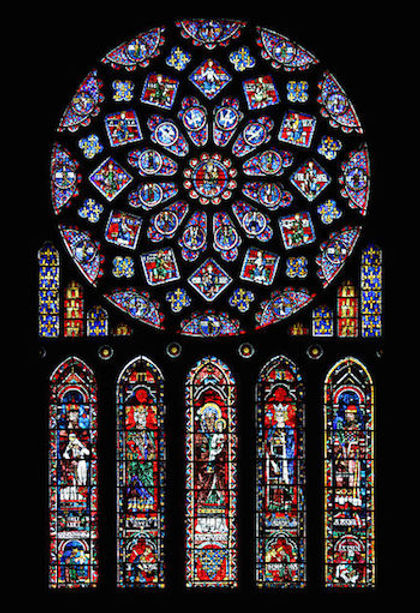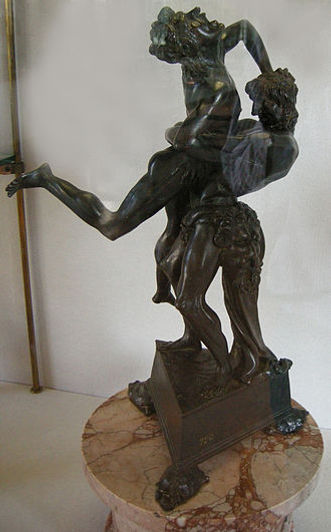<A>
Florence of Lorenzo de' Medici: *
Though without title, Lorenzo assiduously centralized power in his hands, ruling with surrogates in the councils, threats, payoffs & strategic marriages. Between 1469-72 he reformed city government, suppressed family rivalries & served as the supreme arbiter. He ensured peace among the Italian cities through his influence & friendships. Florence flourished, her commercial economy booming during his life. Following the Pazzi conspiracy Easter 1478 war broke between Florence & the pope & only Lorenzo’s personal diplomacy saved the city. He emerged with increased prestige & secured constitutional changes which enhanced Medici power. Thereafter he aimed at a balance of power between the northern Italian states, while keeping France & the Holy Roman Empire out of Italy. Lorenzo The Magnificent was known for his political astuteness & artistic skills. He was a writer & a distinguished vernacular poet, passionate about Classical antiquity. He established a Neo-Platonic academy, a circle of humanist poets, artists & philosophers. They met at the Garden of the Piazza San Marco, Florence. It included Ficino, Mirandola, Poliziano, Botticelli, Bertoldo di Giovanni & Michelangelo. In 1480 Leonardo was living with the Medici & also joined. Lorenzo expanded the family collection of book (the Laurentian Library) & built up a collection of antiquities, gems, cameos, vases & large-scale marble sculptures. He continued Medici patronage of the Church; he enriched the family church of San Lorenzo, where the tombs of Piero & Giovanni de’ Medici were completed by Verrocchio (1469-72). He constantly encouraged his countrymen to commission work from the artists of Florence; he himself was a great patron & commissioned works by Michelangelo, Leonardo & Botticelli. The finest workshop in Florence was none other than Verrocchio’s (1435-88), where many important painters were educated, to include Ghirlandaio, Perugino, Botticelli & Lorenzo di Credi. Leonardo trained & worked here 1466-76 & collaborated with Verrocchio in The Baptism of Christ, painting the young angel holding Jesus' robe. He was also the model for Verrocchio’s bronze statue of David in the Bargello & the Archangel Raphael in Verrocchio’s Tobias & the Angel. Lorenzo was an excellent judge of talent. After seeing a single piece by Michelangelo, he invited the young artist into his household, giving him board, lodging & an allowance. In 1488, age 13, he was apprenticed to the workshop of the painter Ghirlandaio. From 1490-92 he attended the Medici Humanist academy; here his outlook & art were influenced by the most prominent philosophers & writers of the day. He sculpted his first 2 reliefs: Madonna of the Steps & Battle of the Centaurs. In 1492 he was at Lorenzo’s deathbed. The court painter in Lorenzo’s court was Botticelli (famed for his interpretation of female beauty). By 1470 Botticelli had discovered his mature style, his work enriched by Humanistic themes. For the Medici he painted The Adoration of the Magi (1475-76) showing 3 generations of Medici – Cosimo, his son, Piero, and his grandsons, Lorenzo & Guiliano – kneeling before the Christ child. Botticelli’s more important paintings were done under Medici influence & reflects their cultural atmosphere. The Medici commissioned Primavera (Spring) and the Birth of Venus, 1477-78.
<B>
Rome of Leo the Tenth:*
Leo was a lover & patron of the arts & did more than any pope to establish Rome as the centre of European culture. His love of art stemmed from his education in Florence, his studies in Pisa & his extensive travel throughout Europe. He loved the Latin poems of the humanists, the tragedies of the Greeks & the comedies of Cardinal Bibbiena and Ariosto, while relishing the accounts sent back by the explorers of the New World. Leo favoured painting over sculpture. Raphael ibenefitted from Leo’s patronage. He finished the decoration of the Stanze (begun under Julius II) figuring Leo X in some of the scenes. Raphael painted the cartoons for the Sistine Chapel tapestries, one of his highest achievement. A 3rd enterprise was the decoration of the Vatican Loggia, by Raphael's pupils under his direction & designs. The most exquisite of his paintings are the wonderful Sistine Madonna and the "Transfiguration". The architecture of Rome benefited under Leo. As a cardinal, he restored the church of Santa Maria in Domnica after Raphael's designs; as pope he had San Giovanni dei Fiorentini, on the Via Giulia built, after designs by Jacopo Sansovino. His greatest, most difficult task was the continuation of St. Peter's; Bramante remained its chief architect until his death in 1514. Raphael succeeded him, but in his 6 years of office little was done (through lack of means). In 1513 Leo reformed the University of Rome (neglected by Julius II). He restored its faculties, gave larger salaries to the professors & hired distinguished teachers from afar. The famous Latinists Pietro Bembo & Jacopo Sadoleto became papal secretaries, as did the famous poet Bernardo Accolti. Other poets such as Marco Girolamo Vida, Gian Giorgio Trissino & Bibbiena, writers of novelle like Matteo Bandello & hundreds of other literati, received church appointments. He called Janus Lascaris to Rome to give instruction in Greek & established a Greek printing-press from which the first Greek book were printed in Rome (1515). He appointed Raphael custodian of the classical antiquities of Rome. In 1514 the university counted a faculty of 88. As a patron of learning he made the Church a friend of whatever seemed to extend knowledge. Leo was a music lover; the standard of singing in the papal choir was a top priority. Leo paid lavish salaries for the services of professional singers, instrumentalists & composers from France, Germany & Spain. He spent much gold on the acquisition of highly ornamented musical instruments, and he was especially assiduous in securing musical scores from Florence.
<C>
Gothic glass-painting: *
northern Rose window, Chartres Cathedral, 1200; the oldest surviving stained glass windows in France. The upper window is a rose window; the layout of the radiating elements are clearly visible. It portrays the glorification of the Virgin Mary surrounded by prophets & other Biblical figures. Mary is in the small circle in the middle of the window, the other figures radiate out from her. She is also on the centre panel of the long narrow windows below.


<D>
Byzantine gold-ground mosaic: *
Under Justinian I (ruled 527–565 AD) the Empire reconquered much of the historically Roman western Empire including Italy. These mosaics depicting Emperor Saint Justinian I and Empress Theodora in the Basilica of San Vitale were executed shortly after this reconquest. The gold background of the mosaic shows Justinian & entourage inside the church. The figures are placed in a V shape; Justinian in the front & middle showing his importance, with Bishop Maximian on his left, lesser individuals being placed behind them. This placement can be seen through the overlapping feet of the individuals present in the mosaic.
Another panel shows Empress Theodora solemn & formal, with golden halo, crown and jewels, and a group of court women as well as eunuchs. The Empress holds the Eucharistic vessel for wine. Her panel differs from Justinian in having a more complex background, with a fountain, cupola, and lavish hangings.


<E>
Verrocchio (goldsmith):*
In 1468 he produced a bronze candlestick (1.57 meters high) for Carlo di Niccola di Messer Vieri de’ Medici, the gonfaloniere (highest office in Florence) to commemorate the peace of that year. That same year he was contracted to make a golden ball for the lantern of the cupola on the Duomo in Florence. The ball was made of sheets of copper soldered together & hammered into shape and then gilded. It was completed 1471.
<F>
Pollaiuolo (goldsmith): *
Hercules and Antaeus, bronze sculpture 1475

<G>
Piero della Francesca (static space):
The Resurrection, fresco, 1460s in the Palazzo della Residenza, Sansepolcro, Tuscany. Jesus is portrayed in the moment of his resurrection, in the centre, standing on a classical sarcophagus. He is a stern, impassive figure, depicted in an iconic and abstract fixity. He rises over 4 sleeping soldiers, representing the difference between the human & the divine. The landscape, in the dawn light, is symbolic: the contrast between the flourishing young trees on the right & the bare mature ones on the left, alludes to the renovation of men through the Resurrection. Christ's body is perfectly sculpted & as blemish-free as an antique statue with touches of intense humanity: the un-idealised, coarse-featured face, the 3 folds of skin that wrinkle at his belly as he raises his left leg; these emphasise his twofold nature, as both man and God. The composition is unusual in that it contains 2 vanishing points. One is in the centre of the sarcophagus, because the faces of the guards are seen from below. The other is in Jesus’ face. The top of the sarcophagus forms a boundary between the 2 points of view; the steepness of the hills prevents the transition between the 2 points of view from being too jarring.
Spengler posits that Piero della Francesca handles space in a unique Tuscan manner, which he calls static space. Fields of space are attempted & painted, but not unbound or striving into the depths, rather space defined by the senses, with mass, stacked in planes, with sharp outlines & surface definition.

<H>
Florence...Athens: *
Spengler argues that Renaissance painters used a singular perspective (1 point perspective, 1 vanishing point), in conjunction with representing a plurality (several groups or bodies). In contrast the Athenian vase painter focused on a single body of interest, presented without any background or perspective.
see Illustration H [ Greek vases & Renaissance oils]
<I>
Masaccio (frescoes in the Brancacci Chapel): *
Masaccio breaks from the medieval pictorial tradition by using the new Renaissance perspective for his conception of space. His perspective & light create deep spaces where volumetrically constructed figures move in a strongly individualised human dimension. He continued Giotto's path, away from a symbolic vision of man to greater realism. The use of scientific perspective, unified lighting, chiaroscuro & skill in rendering the figures naturalistically established new traditions in Florence- the Renaissance style. Young Michelangelo was one of the many artists who received his artistic training by copying Masaccio's work in the chapel.
<J>
Raphael l (the Vatican Stanze): *
Among other on-going projects, Julius commissioned Michelangelo to paint the Sistine Chapel ceiling. Raphael secretly viewed this monument & was deeply influenced. Raphael had a gift for absorbing influences & rose to the challenge. One of his ripostes was the portrait in The School of Athens of Michelangelo himself, as Heraclitus, clearly drawn from the Sybils & ignudi of the Sistine ceiling. Other figures show the same influences, yet Raphael maintained his own unique style. Michelangelo accused Raphael of plagiarism & even after his death (1520) he grumbled. These large & complex compositions are regarded as among the supreme works of the High Renaissance. They give a highly idealised depiction of the forms represented & the compositions (carefully thought out) achieve "sprezzatura", appearing uncontrived & effortless. The paintings of the first 2 rooms are of the highest quality; the later compositions, those involving dramatic action, are not entirely as successful in conception or execution by the workshop.
<K>
Leonardo (sfumato): *
St. John the Baptist
1513-16, oil painting on walnut wood (Leonardo’s final painting); his sfumato technique at apogee; original size was 69 x 57 cm; depicts St. John the Baptist in isolation. With chiaroscuro (strong contrast between light & dark) the figure emerges from the shadowy background, dressed in pelts, has long curly hair & smiling in an enigmatic manner (reminiscent of the Mona Lisa). He holds a reed cross in his left hand, his right points up to heaven like St Anne in Leonardo's Burlington House Cartoon. Leonardo's use of sfumato conveys the religious content of the picture, the gentle shadows imbue the subject's skin tones with a very soft, delicate appearance, almost androgynous in its effect.